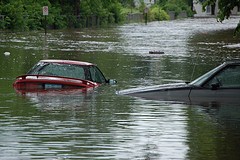 Your homeowners insurance does not cover flood damage. Did you know that?
Your homeowners insurance does not cover flood damage. Did you know that?
It’s true. Without flood insurance, you could end up paying $311 a month for a disaster home loan in order to get your life back in order after a flood.
On the other hand, if you’d had home flood insurance, you would have been paying an average of $370 a year — even less in low to moderate risk areas!
Believe it or not, you should purchase flood insurance even if you don’t live in a flood zone! That’s right, even if your home is in a low to moderate risk area, your neighborhood could still experience a flood.
How do we know this?
Every year new areas flood that have haven’t had a flood in 100 or 200 years! Some of those areas have never flooded before, period. With floods, you just never know.
Fortunately, home flood insurance rates for those who live in an area with a low flood risk are really cheap. It only costs about $100 a year. The peace of mind, and the ability to replace everything you lost due to flood damage is definitely worth it!
What If You’re A Renter?
You don’t have to be a homeowner (or business owner) to purchase flood insurance. As a renter (of a home or business), you can get a flood insurance policy that covers all of your possessions.
The takeaway here is this: The property owner’s insurance only covers the building, not your personal property. Therefore, if you rent a home or business, you should definitely purchase flood insurance.
What If You Live In A High-Risk Area?
Yes, even in high-risk areas, you can still get home flood insurance.
The National Flood Insurance Program protects you from flood damage everywhere with the exception of Coastal Barrier Resources System areas.
How Much Does Flood Insurance Cost?
Coverage starts at just over $100 a year, depending on where you live, and therefore your level of flood risk. Low- to moderate-risk people have a number of affordable options.
Flood insurance maps are created and updated regularly as communities grow and expand.
Now, compare the cost of flood insurance with the true cost that every inch of flood water will set you back.
What Are The Odds Of Your Home Flooding?
If you live in a high-risk flood area, you have a 1 in 4 chance of your home flooding during the course of a 30-year mortgage.
On the other hand, if you live in a low-risk flood zone like I do, then you have a risk of at least one flood in a 100-year time span.
How To Get Flood Insurance
 Contact your homeowner’s or renter’s insurance provider and ask about a flood policy or rider.
Contact your homeowner’s or renter’s insurance provider and ask about a flood policy or rider.
Make sure that your insurance provider participates in the National Flood Insurance Program to ensure that you are getting the best rates available.
If you don’t have an agent already, check out this list of FEMA’s recommended flood insurance agents.
Your Flood Insurance May Not Protect Your Contents!
It’s worth noting that not all flood insurance policies cover contents. Chances are, yours may only cover damage to your home — not to everything inside, like furniture and clothes.
Many families in flood zones thought they were covered because their banks require they pay for flood insurance along with their mortgage. But what many families thought was insured, they’re now learning is completely unprotected. Source
So, whether you already have a flood insurance policy or you’re thinking of buying one, be sure to ask the right questions in order to protect your entire home… including it contents. In order to save you money, some insurers may only give you a price for coverage that protects your property.
A flood insurance policy through the National Flood Insurance Program [which is managed by FEMA] can provide maximum coverage of $250,000 for property and $100,000 for contents. Property and contents coverage must be purchased separately, even though they may form part of the same policy. If you want additional coverage, you can purchase excess flood insurance from private insurers. The average flood insurance policy costs $500 per year, according to the NFIP. Source
Don’t miss: 9 Myths About Flood Insurance



